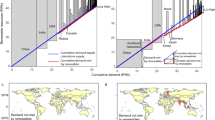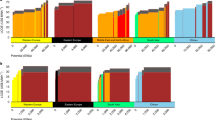Abstract
Operational constraints of the power system and inter-regional trade of electricity make it challenging to predetermine the reduction in emissions from the integration of solar and wind power. Using spatially resolved historical data for solar and wind generation, fossil fuel-based generation, emissions and exports, we isolate the impacts of renewable integration for multiple regions spanning the United States. Here we show regional differences for the reduction of carbon dioxide, sulfur dioxide and nitrogen oxides emissions, with a wider range of outcomes for regional wind power. Given the heterogeneity in transmission infrastructure, some regions have limited capacity to increase electricity exports to neighbouring regions. For both solar and wind generation, we identify the regions that retain nearly all of the emissions reductions locally and those that increase net exports, reducing emissions in neighbouring regions. Our results show lower rates of emissions mitigation than previous studies that relied on less-contemporary data or utilized simulated renewable generation. These differences may reflect the longer-term trends in power-sector emissions reductions and the importance of utilizing observed renewable generation data.
This is a preview of subscription content, access via your institution
Access options
Access Nature and 54 other Nature Portfolio journals
Get Nature+, our best-value online-access subscription
$29.99 / 30 days
cancel any time
Subscribe to this journal
Receive 12 digital issues and online access to articles
$119.00 per year
only $9.92 per issue
Buy this article
- Purchase on Springer Link
- Instant access to full article PDF
Prices may be subject to local taxes which are calculated during checkout





Similar content being viewed by others
Data availability
The datasets generated and/or analysed during the current study are available in a GitHub repository: https://github.com/hfell20/Emissions_and_Renewables.
Code availability
The code developed during the current study is available in a GitHub repository: https://github.com/hfell20/Emissions_and_Renewables.
References
Cullen, J. Measuring the environmental benefits of wind-generated electricity. Am. Econ. J. Econ. Policy 5, 107–133 (2013).
Kaffine, D. T., McBee, B. J. & Lieskovsky, J. Emissions savings from wind power generation in Texas. Energy J. 34, 155–175 (2013).
Novan, K. Valuing the wind: renewable energy policies and air pollution avoided. Am. Econ. J. Econ. Policy 7, 291–326 (2015).
Fell, H. & Kaffine, D. T. The fall of coal: joint impacts of fuel prices and renewables on generation and emissions. Am. Econ. J. Econ. Policy 10, 90–116 (2018).
Callaway, D. S., Fowlie, M. & McCormick, G. Location, location, location: the variable value of renewable energy and demand-side efficiency resources. J. Assoc. Environ. Resour. Econ. 5, 39–75 (2018).
Holladay, J. S. & LaRiviere, J. The impact of cheap natural gas on marginal emissions from electricity generation and implications for energy policy. J. Environ. Econ. Manage. 85, 205–227 (2017).
Millstein, D., Wiser, R., Bolinger, M. & Barbose, G. The climate and air-quality benefits of wind and solar power in the United States. Nat. Energy https://doi.org/10.1038/nenergy.2017.134 (2017).
Siler-Evans, K., Azevedo, I. L. & Morgan, M. G. Marginal emissions factors for the US electricity system. Environ. Sci. Technol. 46, 4742–4748 (2012).
Hawkes, A. D. Estimating marginal CO2 emissions rates for national electricity systems. Energy Policy 38, 5977–5987 (2010).
Hawkes, A. D. Long-run marginal CO2 emissions factors in national electricity systems. Appl. Energy 125, 197–205 (2014).
Li, M., Smith, T. M., Yang, Y. & Wilson, E. J. Marginal emission factors considering renewables: a case study of the US Midcontinent Independent System Operator (MISO) system. Environ. Sci. Technol. 51, 11215–11223 (2017).
Ryan, N. A., Johnson, J. X. & Keoleian, G. A. Comparative assessment of models and methods to calculate grid electricity emissions. Environ. Sci. Technol. 50, 8937–8953 (2016).
Donti, P. L., Kolter, J. Z. & Azevedo, I. L. How much are we saving after all? Characterizing the effects of commonly varying assumptions on emissions and damage estimates in PJM. Environ. Sci. Technol. 53, 9905–9914 (2019).
Siler-Evans, K., Azevedo, I. L., Morgan, M. G. & Apt, J. Regional variations in the health, environmental, and climate benefits of wind and solar generation. Proc. Natl Acad. Sci. USA 110, 11768–11773 (2013).
Graff Zivin, J. S., Kotchen, M. J. & Mansur, E. T. Spatial and temporal heterogeneity of marginal emissions: implications for electric cars and other electricity-shifting policies. J. Econ. Behav. Organ. https://doi.org/10.1016/j.jebo.2014.03.010 (2014).
Tamayao, M. A. M., Michalek, J. J., Hendrickson, C. & Azevedo, I. M. Regional variability and uncertainty of electric vehicle life cycle CO2 emissions across the United States. Environ. Sci. Technol. 49, 8844–8855 (2015).
Smith, C. & Hittinger, E. Using marginal emission factors to improve estimates of emission benefits from appliance efficiency upgrades. Energy Effic. 12, 585–600 (2019).
Brinkman, G. Renewable Electricity Futures: Operational Analysis of the Western Interconnection at Very High Renewable Penetrations Technical Report NREL/TP–6A20–64467 (National Renewable Energy Laboratory, 2015).
Novacheck, J., Brinkman, G. & Porro, G. Operational Analysis of the Eastern Interconnection at Very High Renewable Penetrations Technical Report NREL/TP–6A20–71465 (National Renewable Energy Laboratory, 2018).
Sepulveda, N. A., Jenkins, J. D., de Sisternes, F. J. & Lester, R. K. The role of firm low-carbon electricity resources in deep decarbonization of power generation. Joule 2, 2403–2420 (2018).
Buonocore, J. J. et al. Health and climate benefits of different energy-efficiency and renewable energy choices. Nat. Clim. Change 6, 100–106 (2016).
Arbabzadeh, M., Sioshansi, R., Johnson, J. X. & Keoleian, G. A. The role of energy storage in deep decarbonization of electricity production. Nat. Commun. https://doi.org/10.1038/s41467-019-11161-5 (2019).
Novacheck, J. & Johnson, J. The environmental and cost implications of solar energy preferences in renewable portfolio standards. Energy Policy https://doi.org/10.1016/j.enpol.2015.06.039 (2015).
Johnson, J. & Novacheck, J. Emissions reductions from expanding state-level renewable portfolio standards. Environ. Sci. Technol. https://doi.org/10.1021/es506123e (2015).
Raichur, V., Callaway, D. S. & Skerlos, S. J. Estimating emissions from electricity generation using electricity dispatch models: the importance of system operating constraints. J. Ind. Ecol. 20, 42–53 (2016).
Deetjen, T. A. & Azevedo, I. L. Reduced-order dispatch model for simulating marginal emissions factors for the United States power sector. Environ. Sci. Technol. 53, 10506–10513 (2019).
Voorspools, K. R. & D’haeseleer, W. D. An evaluation method for calculating the emission responsibility of specific electric applications. Energy Policy 28, 967–980 (2000).
Marnay, C. et al. Estimating Carbon Dioxide Emissions Factors for the California Electric Power Sector Report LBNL–49945 (Lawrence Berkeley National Laboratory, 2002).
Katzenstein, W. & Apt, J. Air emissions due to wind and solar power. Environ. Sci. Technol. 43, 253–258 (2009).
Oates, D. L. & Jaramillo, P. Production cost and air emissions impacts of coal cycling in power systems with large-scale wind penetration. Environ. Res. Lett. https://doi.org/10.1088/1748-9326/8/2/024022 (2013).
MISO ‘self-commitment’ trends MISO Perspective (Midcontinent Independent System Operator, 2020).
Electric Power Monthly Technical Report (US Energy Information Administration, 2019).
Buonocore, J. J. et al. Climate and health benefits of increasing renewable energy deployment in the United States. Environ. Res. Lett. 14, 114010 (2019).
Holland, S. P., Mansur, E. T., Muller, N. Z. & Yates, A. J. Decompositions and policy consequences of an extraordinary decline in air pollution from electricity generation. Am. Econ. J. Econ. Policy (in the press).
Ryan, N., Johnson, J. & Keoleian, G. Comparative assessment of models and methods to calculate grid electricity emissions. Environ. Sci. Technol. https://doi.org/10.1021/acs.est.5b05216 (2016).
EIA Form 930 (US Energy Information Administration, 2020).
Henry Hub Natural Gas Spot Price (US Energy Information Administration, 2020); https://www.eia.gov/dnav/ng/hist/rngwhhdm.htm
Air Markets Program Data (US Environmental Protection Agency, 2020).
Homeland Infrastructure Foundation-Level Data, Electric Retail Service Territories (US Department of Homeland Security, 2020).
Acknowledgements
We acknowledge B. Copeland for her invaluable support in data collection and management, as well as the North Carolina State University Chancellor’s Faculty Excellence Program for Sustainable Energy Systems and Policy and the Department of Civil, Construction & Environmental Engineering Research Experience for Undergraduate program.
Author information
Authors and Affiliations
Contributions
H.F. constructed the model. Both authors conceived the study, analysed the results and wrote and reviewed the manuscript.
Corresponding author
Ethics declarations
Competing interests
The authors declare no competing interests.
Additional information
Peer review information Nature Sustainability thanks Jonathan Buonocore, Kyle Siler-Evans and the other, anonymous, reviewer(s) for their contribution to the peer review of this work.
Publisher’s note Springer Nature remains neutral with regard to jurisdictional claims in published maps and institutional affiliations.
Supplementary information
Supplementary Information
Supplementary Figs. 1 and 2 and Tables 1–41.
Rights and permissions
About this article
Cite this article
Fell, H., Johnson, J.X. Regional disparities in emissions reduction and net trade from renewables. Nat Sustain 4, 358–365 (2021). https://doi.org/10.1038/s41893-020-00652-9
Received:
Accepted:
Published:
Issue Date:
DOI: https://doi.org/10.1038/s41893-020-00652-9
This article is cited by
-
Study on the spatial correlation effects and influencing factors of carbon emissions from the electricity industry: a fresh evidence from China
Environmental Science and Pollution Research (2023)
-
Cleaning the grid
Nature Sustainability (2020)



